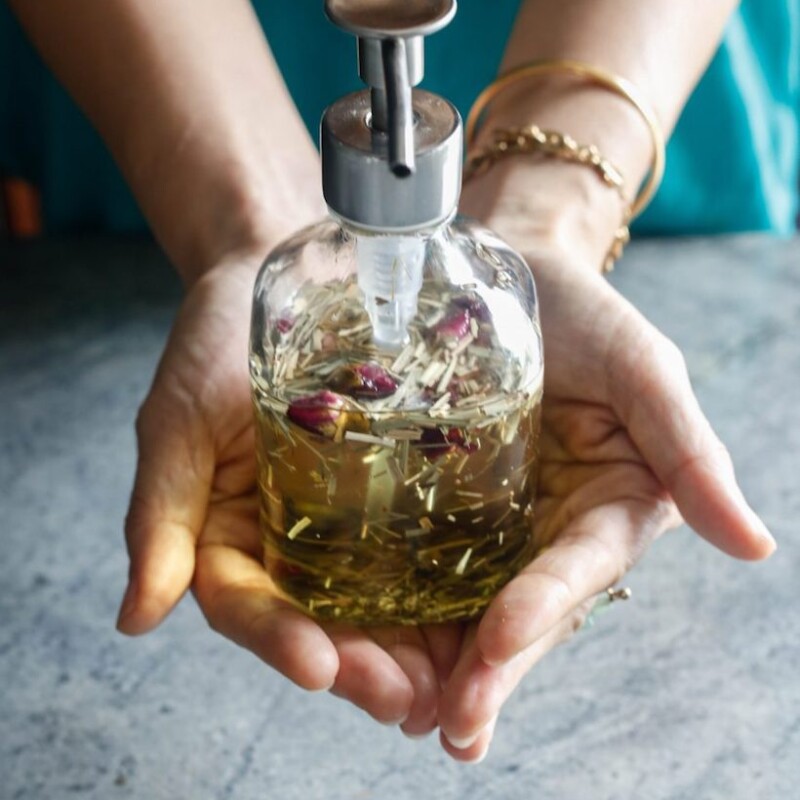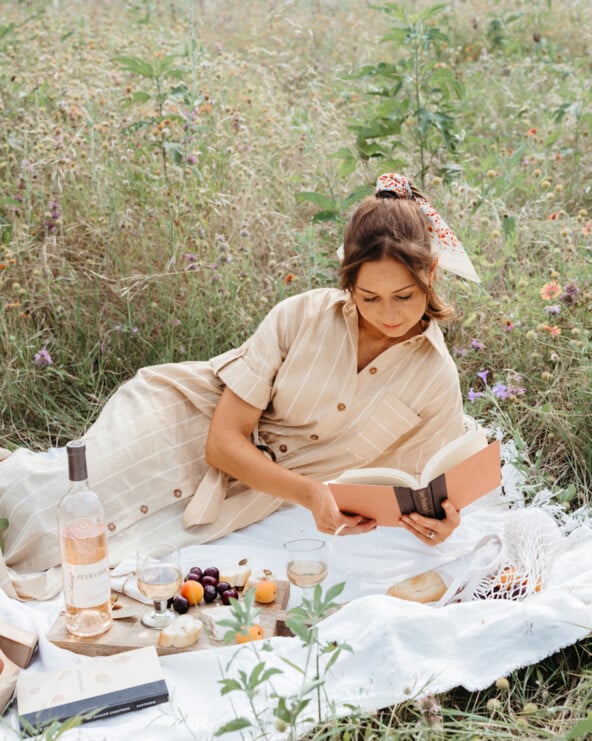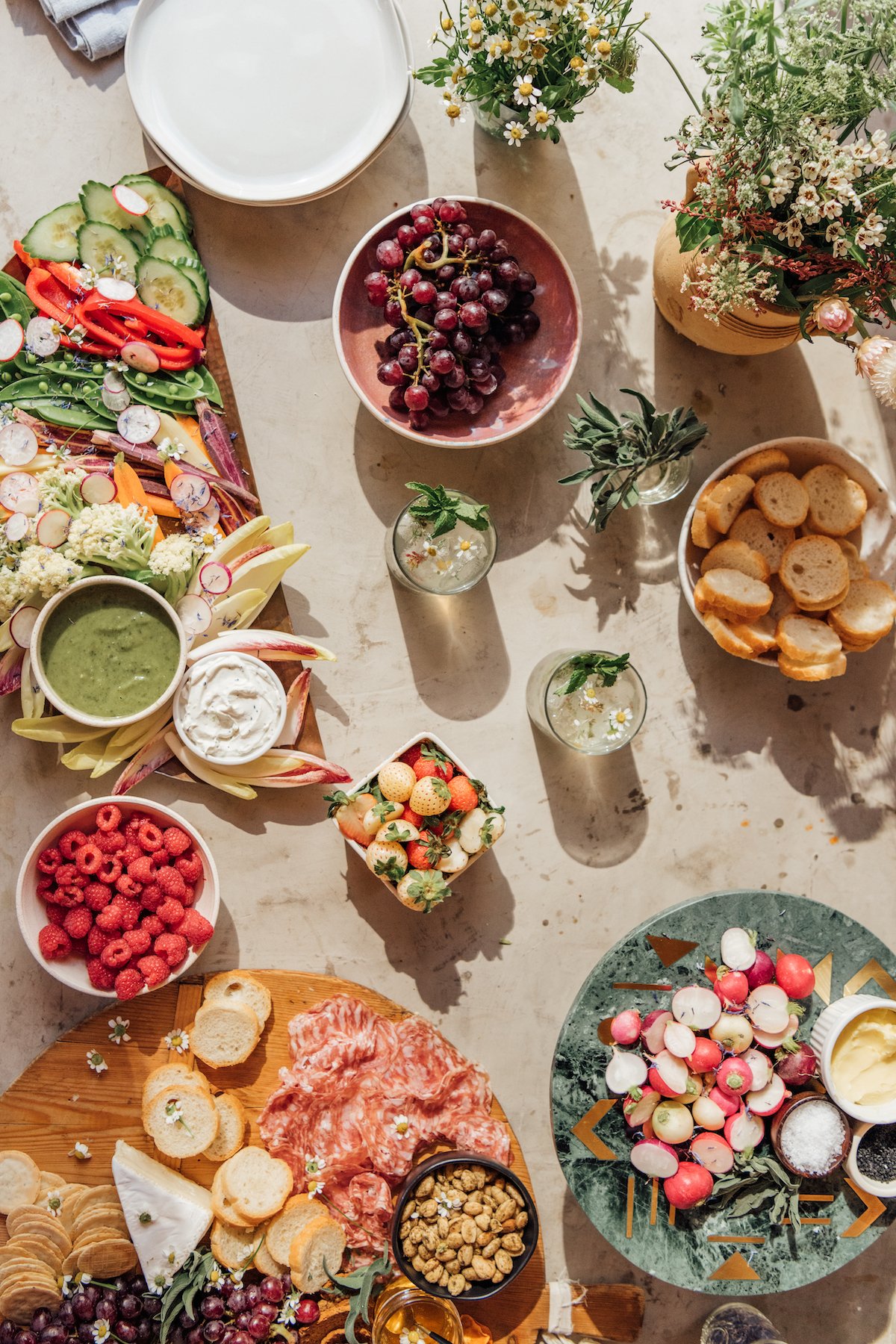Editor’s note: A couple years ago, Adina Grigore shared with us these 6 Recipes for Beautiful Skin from her first book, and to this date, it remains one of my favorite beauty stories of all time. The simple ingredient combinations and vibrant photos instantly made me want to call up my best girlfriends for an impromptu slumber party and play spa/mad scientist all weekend long. So, when I heard that the skin guru (and founder of one of my favorite brands) had written a second book — this one all about essential oils — I was on board from the get-go. Lucky for us, Adina joins us today to take us on a crash course on the topic of essential oils and give us a sneak peek at what we can expect from her sophomore authorship. Without further ado…
From Adina: I like to think Just the Essentials is a companion and an extension of my first book, Skin Cleanse. In Skin Cleanse I detailed out my skincare and wellness philosophy, which is rooted in the axiom of using whole, natural ingredients to heal skin. Switching to a natural, simple skincare routine utterly transformed my skin — and my health — and is the inspiration behind the five-ingredients-or-less products of S.W. Basics.
In my crusade to clean up my skin and personal care routine, however, I stumbled upon essential oils. At first I thought they just smelled great and served as an amazing alternative to synthetic fragrance (which is probably one of the most irritating ingredients out there). But I quickly learned that essential oils didn’t just make my DIYs more fragrant, they made them better. Essential oils are powerful, therapeutic plant compounds that can work in myriad of ways to improve your life and your health.
Now, I not only use them in my skincare, I integrate them in all aspects of my life: Tea tree oil to make toothpaste, eucalyptus oil to ward off insects, lemon oil to clean counters, clary sage oil to combat hormonal acne, sweet orange oil to boost my mood… This list is virtually limitless.
featured image by Little Green Dot

Rosemary
Rosemary oil is a stimulant. When inhaled, the aroma of rosemary has been shown to increase heart rate, blood pressure, and respiratory rate, and boost your immune system. It has also been shown to increase brain wave activity and aid the part of your nervous system that controls organ function. But while it stimulates many bodily systems, it also decreases levels of the stress hormone cortisol.
Rosemary is commonly found in skincare, especially natural products, because it not only has topical benefits but also will extend the shelf life of a product exponentially.
Suggested use:
Dilute 3-7 drops of rosemary oil into coconut oil or jojoba oil as a chest-clearing cold rub (think of it as an all-natural Vick’s VaporRub.)

photo from the free people blog
Clary Sage
Clary sage possesses myriad beneficial properties for the skin: It’s antibacterial, astringent, antiseptic, and can help improve circulation. Although the ancient Egyptians used clary sage in medicinal practices, it wasn’t until medieval times that clary sage really took off. During this time, doctors and herbalists used clary sage seeds to help treat vision problems; “clary” is derived from the Latin word for clear, “clarus.” Clary sage was also used to flavor wine. It was often referred to as “muscatel sage” because of its similarity to German muscat wine. Someone, somewhere, got clever — maybe while drunk off clary sage wine? — and mashed up the two nicknames. Hence: clary sage.
Clary sage has been lauded for its ability to regulate hormones, and its scent is thought to have antidepressant effects. A 2014 study of twenty-two postmenopausal women in their fifties — some of whom were depressed — showed that breathing diffused clary sage helped to alleviate participants’ depression by lowering cortisol levels and improving thyroid hormone levels. And a 2012 study revealed that clary sage — along with lavender and marjoram — makes an effective massage treatment for alleviating menstrual pain and cramping.
Suggested use:
Make a cramp relief oil by combining 1 tablespoon evening primrose oil, 10 drops Roman chamomile essential oil, 10 drops clary sage essential oil, and 10 drops marjoram essential oil. Use like a massage oil, rubbing all over your lower abdomen and/or anywhere else you have pain.
http://blog.freepeople.com/2015/10/diy-fall-hair-perfume/

Lavender Oil
What we call lavender is actually Lavandula angustifolia, one type of lavender among thirty-nine total species. Different species have different properties, but all types of lavender contain large proportions of linalool, linalyl acetate, eucalyptol, and camphor. That’s a lot of components to have in high quantities, and it’s the reason it’s such a powerhouse essential oil.
Lavender is sedative, antispasmodic, antianxiety, anti-inflammatory, antimicrobial, antioxidant, antibacterial, anesthetic, anticarcinogenic, immune-boosting, and antiviral.
Suggested use:
Make a face mist with 2 ounces lavender hydrosol and 30 drops lavender essential oil. Combine the hydrosol and essential oil in a glass bottle with a spritzer top. Shake well, spray face, body, or air around you throughout the day. This makes at least 60 uses, but be sure to store it in a cool, dark place and use within 6 months.

Lemon Oil
Lemon oil is a powerful antibacterial, astringent, and antiseptic agent. It also has a high concentration of D-limonene, a compound that assists in diminishing the appearance of wrinkles, promoting circulation, and toning the skin. In fact, recent research showed that D-limonene exhibits powerful skin-repairing and anti-inflammatory properties.
Suggested use:
- Dilute 3-7 drops of lemon oil into one tablespoon of jojoba oil as a repairing skin treatment.
- Make a disinfecting countertop treatment by combining 1 cup water, 1/2 cup white vinegar, 1/4 hydrogen peroxide, and 20 drops lemon oil. Shake thoroughly before use.

photo from the artful desperado
Sweet Orange
In studies, orange oil reduced anxiety when it was inhaled and when applied topically, it slowed down participants’ pulse rates and breathing rates, while they also reported feeling more cheerful and vigorous.
It can be a little tricky to incorporate orange oil into your life because it doesn’t diffuse well, and, like lemon oil, it can make your skin photosensitive when applied topically, so I recommend using it in products you plan on rinsing off in the shower, and not going higher than 12 drops of essential oil per ounce of carrier oil. I find the smell of sweet orange oil to be so fragrant that you need only a very small amount when DIYing.
One important note: Make sure you purchase sweet orange oil and not bitter orange since bitter orange oil is very photo-toxic. In the meantime, below is a quick mood-boosting blend you can mix just to smell from time to time, like I do.
Suggested use:
Make a depression-fighting oil blend with 2 parts sweet orange oil, 1 part lemon oil, and 1 part bergamot oil. Mix in a small bottle with a lid. Always seal tightly to prevent the oils from evaporating.

Eucalyptus
Eucalyptus essential oil is definitely not for the weak. Even if you’ve never smelled it directly, you’ve probably smelled something that contains it—like Vicks VapoRub, maybe? The scent is similar to camphor (another ingredient in VapoRub, and also in Tiger Balm) and slightly minty. It will clear your airways super-quick and can take your breath away.
Here’s what else it’s been proved to do: It works as a pesticide and has the ability to kill fungus, bacteria, insects, mites, and weeds. When sprayed into the air at fifteen-second intervals for one hour, it also kills 99 percent of influenza virus particles. Eucalyptus has even been shown to kill the drug-resistant parasite that causes malaria through both direct contact and vapor, without harming the red blood cells that contain the parasite.
Suggested use:
Make eucalyptus moth repellent! You’ll need 2 tablespoons eucalyptus essential oil, 1 tablespoon lavender or peppermint essential oil, and 4–5 large cotton balls. Pour eucalyptus essential oil out into a glass or ceramic bowl. Add lavender or peppermint essential oil. Using chopsticks or wearing gloves, dip cotton into bowl just enough to soak it halfway. Set the soaked cotton balls on shelves in your kitchen, closet, or drawers, making sure they aren’t in direct contact with your clothing. Refresh with a new batch when the oil has evaporated.

photo from the free people blog
Lemongrass Oil
Lemongrass is a fast-growing, tropical grass native to Sri Lanka and south India, and is now cultivated in warm climates in Africa and Asia. The entire plant is utilized in everything from tea to cleaning products, and it has been used for years in Indian healing traditions to treat maladies like gastrointestinal issues and fever (it earned the nickname “fever grass.”)
Research also shows that lemongrass essential oil is antibacterial and anti-fungal, antimicrobial, anti-inflammatory, and can be a potent insect repellent. Its antifungal properties are especially helpful in combating the nasty yeast associated with dandruff. One study noted that participants who used a dandruff tonic with a 10 percent concentration of lemongrass oil saw a significant reduction in dandruff in as little as a week.
Suggested use:
Make a lemongrass bath oil with 1 tablespoon avocado oil, 1 tablespoon sesame oil, and 4 drops lemongrass essential oil. Combine all of the ingredients in a bottle and shake well. Pour into your bath.

Tea Tree Oil
Tea tree oil is antiviral, anti-inflammatory, and exhibits anticancer activity. It kills oral bacteria for up to two weeks, treats gingivitis, heals mild to moderate dandruff, kills the influenza virus, and has been shown to slow and even reverse the growth of tumors in mice. Tea tree oil also works like benzoyl peroxide to treat acne. It takes longer, but causes fewer side effects, while being less drying than benzoyl peroxide.
The only place that tea trees grow naturally is in Australia, but they grow super abundantly there. Traditionally, native Australian cultures used tea tree leaves to treat coughs and colds, heal wounds, and alleviate sore throats and skin ailments.
Suggested uses:
- Make a spot treatment by diluting 3-7 drops tea tree oil into coconut oil.
- Make homemade mouthwash with 1 cup water, 1 tablespoon hydrogen peroxide, and 2–6 drops tea tree oil. Pour the ingredients into a bottle and shake well before using. Follow by brushing teeth and store for up to 1 year.

Peppermint Oil
Peppermint oil is made up mostly of menthol and menthone. It is a stimulant, antispasmodic, antiviral, antimicrobial, anti-fungal, and antioxidant. It is an effective treatment for head-aches: Participants in one study reported a significant reduction in the pain of their tension headaches within fifteen minutes, and the pain continued to drop for the following hour.
Peppermint oil helps soothe nausea, improves concentration and memory, and is an analgesic, which means it numbs and kills pain on the skin.
Suggested use:
Do like us and make a Peppermint Lip Balm!

Cinnamon Oil
Derived from both the bark and leaf of the Cinnamomum verum tree, cinnamon is actually one of history’s oldest essential oils, with the Egyptians recording their extensive use of it in Ebers Papyrus, a medical text dating to approximately 1550 BCE.
In aromatherapy, cinnamon essential oil can be used to help clear up chest colds. Applied topically, it can soothe muscle aches and pains, thanks to its antispasmodic and analgesic properties. It’s also an antiseptic and makes a powerful natural preservative. It is both antibacterial and antimicrobial, as well as being anti-inflammatory, and pain-relieving.
Suggested use:
Make a migraine healing oil by combining 2 drops cinnamon leaf essential oil and 1 tablespoon olive oil. Massage onto temples and between eyebrows to alleviate headaches.






